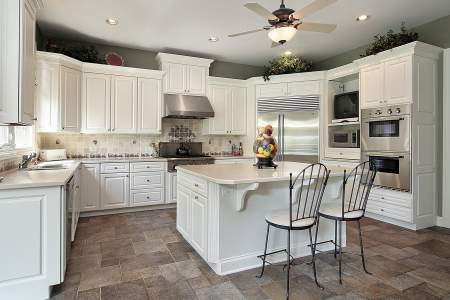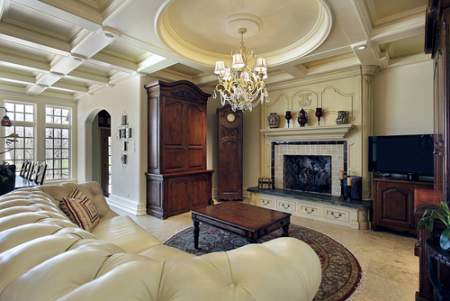When you are ready to sell your home or purchase a home, you will be faced with many questions and issues. One of the areas of concern for many potential buyers and sellers is the definition of a fixture or fitting. Knowing what items will remain in the home and what items are not included in the contract of sale is crucial. Below is a discussion of some of the issues that buyers and seller face when deciding what is included in the sale of a home.
🏡 Details in a Real Estate Listing
 When you hire a real estate agent to list your home for sale, the agent prepares a real estate listing. A typical real estate listing includes:
When you hire a real estate agent to list your home for sale, the agent prepares a real estate listing. A typical real estate listing includes:
- Photographs of the home;
- The number of bedrooms and bathrooms;
- The square footage of the home;
- Purchase price;
- Conditions of sale or contingencies; and,
- Other terms and conditions relevant to the sale.
An experienced real estate agent understands the terms to use in a real estate listing to encourage interest in the property, such as gourmet kitchen, walk-in closets, renovated master bathroom, and updated kitchen. Listing your home in the Multiple Listing Service (MLS) increases interest in your home because all real estate agents with access to the MLS can see your home for sale. However, this is different from the listing contract with your realtor.
The listing contract with your real estate agent is the agreement between you and the agent regarding the terms and conditions of representation. The contract should specify details such as the sales prices, terms of sale, length of contract, real estate commission, contingencies, dispute resolution, when is the commission earned, agency duties, and use of a lockbox. The listing contract should be very detailed and outline every agreement between you and the agent.
During the process of negotiating the listing contract, you should voice concerns of the fixtures and fittings to be excluded or included in any contract of sale. You and your real estate agent should conduct a thorough walk-through of your home, including the exterior and any other structures, to ensure you both are on the same page regarding what will and will not be included in the sale of the home.
🗣 Communicate with Your Real Estate Agent
Communication with your real estate agent is an essential and crucial factor in determining whether the process of buying or selling a home will be smooth or difficult. Buyers and sellers need to rely on their agent to provide guidance, advice, and support throughout the process, especially if this is their first real estate transaction. The real estate agent is the professional who understands the process. Therefore, a realtor has an obligation and duty to be an advocate for the client and do everything in the realtor’s power to make the real estate transaction as smooth and pleasant as possible.
However, it is also up to the client to work with the real estate agent as a partner in the process. To be a good partner, you must communicate with your agent about your expectations and requirements. Your real estate agent can help you find the right home for you and your family; however, he cannot read your mind. You must speak up and ask questions when you are unclear about something.
For example, one of the most common problems in the sale of a home is the dispute over fixtures and fittings. It is assumed that doors, windows, plumbing, electricity, roofs, flooring, and other “construction” items will remain with the home. However, appliances, rugs, light fixtures, faucets, electrical outlet covers, and other items in the home can pose a potential problem for buyers and sellers if they disagree as to what is and is not a fixture or fitting.
Below is a discussion about some of the problems sellers and buyers face when determining what will and will not be included in the sale of a home. However, one of the best ways to avoid this problem is to communicate with your real estate agent.
If you see something in the home that you want to remain in the home, speak up. Tell your realtor you want those wall sconces or that decorate hall mirror to stay in the home. Your realtor may be able to work out an agreement if the item is not a fixture, but he cannot do this unless you tell him that leaving this item in the home is a requirement for you before the contract is signed.
🚪 It’s Not Just About Appliances
 When you are looking for a home, it is very important that you understand what is and is not included in the purchase price of the home. Many buyers assume that an item will be left in the home only to be disappointed when they enter the home after closing the real estate transaction.
When you are looking for a home, it is very important that you understand what is and is not included in the purchase price of the home. Many buyers assume that an item will be left in the home only to be disappointed when they enter the home after closing the real estate transaction.
While most appliances may be included in the sale of a home, appliances are not automatically fixtures. Appliances are large and may be difficult to move, but unless they are permanently affixed to the home (i.e. walk-in refrigerator), the appliances can be removed. Therefore, it is very important that a purchase agreement or contract for sale specifically state whether each appliance will be included in the sale or be removed prior to closing.
Because there can be a great deal of confusion regarding what items will remain in the home and included in the sales price, it is a good idea to carefully evaluate each room and area of the home to create a list of items that you would want to remain with the home. For example, some things that you might assume would be a fixture and remain in the home include:
- Above ground swimming pools
- Projection televisions;
- Above ground spas;
- Fish in a Koi pond;
- Home theater systems; and,
- Window treatments.
While the above items may appear to be fixtures to a buyer, these items are generally not fixtures. If a buyer does not specify in the contract that these items should remain in the home and are included in the sales price, the seller is free to remove the items prior to closing.
🎛 What is a Fixture?
A fixture is generally anything that is firmly attached to the home or ensconced in the ground. To be considered a fixture, the item does not need to be inside the home. Because fixtures are a source of disputes between sellers and buyers, many states have enacted guidelines or laws defining what constitutes a fixture for real estate transactions. Therefore, working with an experienced real estate agent in your area can reduce the chance of a dispute over what is and what is not a fixture.
A good rule of thumb to test whether an item is a fixture is to look at these five factors:
- How is the item attached? Is the item permanently attached or affixed to a surface with screws, glue, nails, pipes, or screws? However, you cannot assume that something that can be removed is not a fixture. Lights and faucets can be removed, but they are generally considered fixtures. The method of attachment is just one factor.
- Is the item an integral part of the home? If the home was adapted to fit an appliance, such as a built-in refrigerator or television screen, this could make the item a fixture. You can unplug the item, but removing it could damage the home.
- Who are the parties involved? The nature of the relationship between the parties could impact the result. If the parties are landlord and tenant, the tenant may be given preference. Likewise, if the dispute is between a buyer and seller, the buyer may prevail.
- What was the intention when the item was installed? Did the owner intend for the item to become a permanent part of the home, such as a built-in bookcase or a gazebo on a concrete foundation?
- What was the agreement between the parties? The written agreement between the parties in the purchase contract is given strong weight when determining whether an item is a fixture. Therefore, defining anything out of the ordinary in the contract is the best way to protect yourself and decrease the chance of a dispute over whether an item is a fixture.
Remember, when in doubt, add a clause to the contract that specifically states whether an item is or is not a fixture.
🔩 What is a Fitting?
 Fixtures and fittings are closely related and sometimes confused. Typically, a fixture is an item that is “fixed” to a wall, floor, ceiling, or other surface. A fitting is a freestanding item. A fitting may or may not be included in the sale of a home. You would use many of the same factors in determining if the fitting should remain in the home as you would to determine if a fixture is included in the sale of a home.
Fixtures and fittings are closely related and sometimes confused. Typically, a fixture is an item that is “fixed” to a wall, floor, ceiling, or other surface. A fitting is a freestanding item. A fitting may or may not be included in the sale of a home. You would use many of the same factors in determining if the fitting should remain in the home as you would to determine if a fixture is included in the sale of a home.
However, many items that fall under the definition of fittings are not included in the transfer of the home. Therefore, it is very important that you clearly define what you consider to be a fixture versus a fitting when you are discussing a contract with your real estate agent. If you see an item that you believe should remain in the home, be vocal about your belief. Otherwise, you might find that the item was considered a fitting and was not included in the sale of the home.
Examples of fittings include:
- Some appliances, like ovens, refrigerators, washing machines, and dryers
- Curtains and blinds
- Sofas, chairs, and freestanding furniture
- Lamp shades and lamps
- Mirrors
- Paintings and artwork
- Rugs and carpets
✍️ Get Things in Writing
Again, the only way to ensure that an item is included in the sale of a home is to include the agreement in the written contract. Sellers and buyers need to be very specific about what they believe is included and not included in the transfer of the home. One of the most common problems in a real estate transaction is disputes over the definition of fixtures and fittings. Most consumers do not have a working knowledge of the legal definition of these terms. To make matters more confusing, there is not always a detailed legal answer for some items in a home.
Experienced real estate agents understand the difference between fixtures and fittings and they know what items are and are not considered a part of the real estate transaction. However, even some realtors who do not have a great deal of experience can blur the lines between what is included and what is excluded from a contract for sale.
It cannot be stressed enough that you need to get everything in writing to decrease the chance you will find yourself in a heated dispute with the other party. To protect yourself as a seller or buyer, you should insist upon a detailed, written contract. If you have a written contract, your chances of prevailing in a dispute are better than if you are trying to make your case based on a verbal agreement, assumption, or generally accepted norms.
💲 Closing Costs and Other Financial Inclusions
When you are negotiating a contract of sale or purchase agreement, one of the details that you need to pay close attention to is the payment of closing costs or other financial inclusions.
In a typical real estate closing, the seller and the buyer have closing costs that they are responsible for paying. These are “normal” closing costs assigned to each party. A contract may specify that each party is liable for the party’s customary and normal costs associated with completing the closing and transfer of the home. However, most contracts include detailed language that specifies what costs are assigned to each party.
In general, a seller is responsible for payment of the:
- Real estate commission;
- Pro-rata taxes and HOA fees;
- Preparation of deed;
- Deed stamps and recording costs;
- Payoff of any liens;
- Recording cost for filing releases or satisfaction of liens; and,
- Cost of termite inspection.
A buyer is typically responsible for payment of the:
- Title search;
- Title insurance;
- Any fees related to financing (i.e. origination fee, prepaid interest, credit report, flood certification fee, tax service fee, etc.);
- Appraisal fee;
- Recording fees;
- Homeowner’s insurance premium;
- Pro-rata property taxes;
- Closing attorney fees; and,
- Deed stamps.
The parties can negotiate to have the seller pay some or all the buyer’s closing costs. In many cases, a seller offers to pay a fixed amount, such as up to $3,000, of the buyer’s closing costs as an incentive for the buyer to purchase the home.
If a buyer or seller disagrees about a fixture or fitting, the party can request a financial allocation in the contract. For example, if the seller wants to take the dining room chandelier, he can offer to provide a credit equal to the cost of the chandelier at closing so that the buyer can purchase a new fixture of his choosing. This solution can make both parties happy because the seller takes the item and does not need to replace it while the buyer gets to choose an item that reflects his preferences.
Again, communication with your real estate agent and the other party is the best way to avoid disputes regarding what is included in the purchase of the home.
Your real estate agent is an amazing resource when it comes to home staging. They have experience and understand exactly what appeals to potential buyers. Give the Jackie Ruden Realty Team a call today at 435-272-7710 to learn more about local areas, discuss selling a house, or tour available homes for sale.





